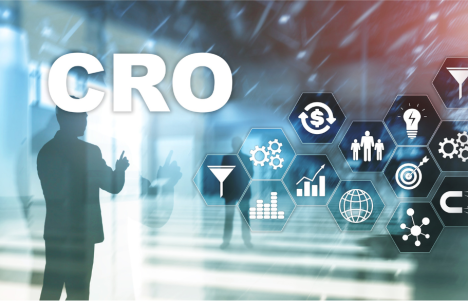Do you know how to increase your B2B conversion rate? Are you aware of the significance of B2B conversion rate optimization in 2023?
In today’s digital age, B2B businesses need to have a strong online presence to stay ahead of the competition. It’s not enough to simply have a website; businesses must ensure that their website is optimized for conversions. Conversion rate optimization (CRO) is the process of increasing the percentage of website visitors who take action, such as making a purchase or filling out a form.
In the highly competitive landscape of B2B marketing, optimizing your website for conversions is critical to success. The importance of B2B conversion rate optimization is only going to increase in 2023. By implementing CRO strategies and continuously analyzing and optimizing your website, you can increase conversions and ultimately drive more revenue for your business.
In this blog post, we’ll explore the significance of B2B conversion rate optimization in 2023 and provide you with actionable tips and strategies to improve your conversion rates.
. . .
Contents
- The Changing B2B Customer Journey in 2023
- Understanding Conversion Rate Optimization (CRO)
- Benefits of B2B CRO in 2023
- Identifying Opportunities for B2B CRO
- Effective Strategies for B2B CRO
- Tools & Technologies for B2B CRO
- Overcoming Challenges in B2B CRO
- Measuring & Analyzing B2B CRO Efforts
- Future Trends & Predictions for B2B CRO
- Conclusion
. . .
The Changing B2B Customer Journey in 2023

Evolution of B2B Buyer Behavior & Digital Advancement
Over the years, B2B buyer behavior and expectations have undergone a significant transformation. Traditionally, B2B buyers relied heavily on sales representatives for information and guidance. However, with the advent of digital technologies and easy access to information, buyers have become more empowered and self-reliant.
Today’s B2B buyers conduct extensive online research, seek peer recommendations, and expect personalized and tailored experiences. They value transparency, efficiency, and convenience throughout their purchasing journey. B2B buyers now demand seamless digital interactions, quick response times, and relevant, engaging content.
Additionally, sustainability, social responsibility, and ethical business practices have gained importance, with buyers seeking partners who align with their values. As a result, B2B businesses need to adapt their strategies to meet these evolving expectations and provide exceptional customer experiences at every touchpoint.
Rising Competition & the Need for Differentiation
The changing B2B customer journey is accompanied by a surge in competition within various industries. As buyers become more knowledgeable and empowered, they have a wider range of options and suppliers to choose from. This heightened competition underscores the importance for businesses to differentiate themselves and stand out in the marketplace.
To succeed in this evolving landscape, companies must go beyond offering standard products or services and focus on delivering unique value propositions. B2B conversion rate optimization allows businesses to develop innovative solutions, provide exceptional customer service, and showcase expertise in specific niches.
By effectively differentiating themselves from competitors, businesses can capture the attention of B2B buyers, establish trust, and secure long-term relationships. Failure to differentiate in such a competitive environment can result in missed opportunities and losing out to more compelling alternatives.
Understanding Conversion Rate Optimization (CRO)

What is Conversion Rate Optimization?
Conversion rate optimization (CRO) is the process of improving a website’s performance to increase the likelihood of a visitor completing a desired action, such as making a purchase or filling out a contact form.
By optimizing various aspects of a website, such as improving user experience (UX), simplifying the checkout process, or creating targeted call-to-actions (CTAs), businesses can make it easier for visitors to become customers.
How Does B2B CRO Help Businesses Increase Sales?
B2B conversion rate optimization helps businesses increase sales in these 4 ways:
B2B CRO focuses on improving UX, making it easier and more enticing for prospects to take the desired actions, such as making a purchase or submitting a form. By streamlining the conversion process and reducing friction, more visitors are likely to convert into paying customers.
B2B CRO identifies and addresses any obstacles or barriers that may be impeding conversions. By analyzing user behavior and feedback, businesses can pinpoint areas of improvement and make necessary changes to enhance the overall customer journey. This reduces drop-off rates and increases the likelihood of successful conversions.
B2B CRO employs data-driven testing and analysis. By testing different variations of elements like headlines, CTAs, or forms, businesses can identify the most effective combination that resonates with their target audience. This optimization based on real user data leads to more persuasive marketing messages, higher click-through rates, and ultimately, more conversions.
B2B CRO allows businesses to maximize their return on investment (ROI) by optimizing their marketing efforts. By converting a higher percentage of their existing website traffic or leads into customers, businesses can generate more revenue without increasing their marketing budget.
By embracing B2B CRO as a priority, businesses can drive significant growth, improve their bottom line, and establish a competitive edge in their industry.
Why Should Businesses Prioritize B2B CRO?
In today’s competitive digital landscape, it’s essential for businesses to prioritize B2B conversion rate optimization because it affects their bottom line. A higher conversion rate means more leads are being converted into customers, which ultimately increases revenue and profitability.
An effective strategy for B2B CRO involves understanding the needs and behaviors of the target audience, creating targeted messaging, and a user-friendly website design that facilitates the buying process.
Additionally, prioritizing CRO enables businesses to stay competitive in their industry by staying ahead of their competitors. Improving the conversion rate gives businesses the opportunity to scale their operations and reach new heights by tapping into untapped markets and creating new business relationships.
Ultimately, B2B conversion rate optimization should be viewed as an investment that can yield significant returns over time.
Benefits of B2B CRO in 2023

In 2023, B2B conversion rate optimization offers several significant benefits for businesses:
Increased Lead Generation & Customer Acquisition: By optimizing conversion rates, businesses can generate more leads and increase their customer base. This translates into a higher number of potential sales opportunities and revenue growth.
Maximize Marketing ROI & Cost-Effectiveness: B2B CRO helps businesses extract the maximum value from their marketing investments. By improving conversion rates, businesses can achieve higher returns on their marketing spend, reducing customer acquisition costs, and increasing overall marketing efficiency.
Enhanced Customer Experience & Building Trust: CRO focuses on improving the user experience and addressing pain points throughout the customer journey. By providing a seamless and enjoyable experience, businesses can build trust, credibility, and loyalty among their B2B customers.
Adaptation to Changing B2B Buyer Expectations: B2B buyers’ expectations and behaviors are constantly evolving. CRO enables businesses to stay in tune with these changes, ensuring their marketing and sales processes align with the needs and preferences of modern B2B buyers.
Competitive Advantage in the B2B Landscape: In a highly competitive market, B2B CRO gives businesses a distinct advantage. By delivering a superior customer experience, optimizing conversions, and outperforming competitors, businesses can differentiate themselves and secure a larger market share.
By prioritizing CRO, businesses can achieve revenue growth, improve marketing efficiency, build trust with customers, stay relevant, and outperform competitors in a rapidly evolving business landscape.
Identifying Opportunities for B2B CRO

Creating & Analyzing the Customer Journey
Creating and analyzing the customer journey is a crucial step in identifying opportunities for B2B conversion rate optimization. To do this effectively, businesses should follow these 7 steps:
Define the Customer Journey Stages: Understand the various stages that B2B buyers typically go through, such as awareness, consideration, decision, and post-purchase. Each stage represents different touchpoints and interactions with the business.
Identify Customer Touchpoints: Map out the touchpoints where potential customers interact with the business, including website visits, email communications, social media engagement, and sales interactions. This helps to identify key areas for optimization.
Analyze User Behavior & Data: Use analytics tools to gather data on how users are engaging with the touchpoints. Analyze metrics such as bounce rates, time on page, conversion rates, and drop-off points to pinpoint areas of improvement and potential barriers to conversion.
Gather Customer Feedback: Utilize surveys, interviews, or feedback forms to gather insights directly from B2B customers. Understanding their pain points, challenges, and expectations at each stage of the customer journey can reveal opportunities for optimization.
Identify Conversion Roadblocks: Based on the data analysis and customer feedback, identify any roadblocks or friction points that may hinder conversions. This could include confusing navigation, lengthy forms, lack of trust signals, or inadequate information.
Develop Optimization Strategies: With a clear understanding of the customer journey and identified roadblocks, develop strategies to optimize each touchpoint. This may involve improving website design, simplifying the conversion process, personalizing content, or enhancing customer support.
Implement & Test Changes: Implement the proposed optimization strategies and conduct A/B testing to measure the impact of the changes. Continuously monitor the results and iterate based on data-driven insights.
By carefully analyzing the customer journey, businesses can uncover opportunities to optimize the B2B conversion process, improve user experience, and ultimately increase conversion rates. This iterative approach allows for continuous improvement and better alignment with the needs and expectations of B2B customers.
Crafting User Stories to Enhance Engagement With Your Product or Services
Crafting user stories for your website plays a crucial role in helping uncover potential needs your customers have while interacting with your website. By addressing these needs you’ll improve your conversion rate.
User stories take an empathetic approach to how your customers experience your website. By going through your website with the mindset of a specific customer type with a specific need you can more effectively resonate with your audience.
Additionally, user stories create a deeper understanding of your product or service, its value proposition, and how it addresses pain points. This educational approach builds trust, credibility, and confidence in potential customers, increasing the likelihood of conversions.
By leveraging user stories as part of your B2B conversion rate optimization strategy, you can engage visitors, communicate your unique selling points, and demonstrate the tangible benefits of your product or service, ultimately leading to higher conversion rates and business growth.
Unlocking B2B CRO: Example Opportunities Ranked by Impact & Difficulty
Now that we have a clear understanding of the importance of B2B CRO and have taken the time to develop customer journeys and user stories, it’s time to delve into each CRO opportunity in detail. We outlined some example opportunities that your business may have. Remember that each business will have a unique set of opportunities.
Here are 12 examples of CRO tactics:
Implement Personalization: Personalize website content, offers, and recommendations based on user behavior and preferences. (Impact: High, Difficulty: Medium.)
Streamline Conversion Process: Simplify and optimize the conversion funnel by reducing form fields, removing unnecessary steps, and improving the user interface. (Impact: High, Difficulty: Medium.)
Enhance Call-to-Action (CTA) Design: Improve the visibility, clarity, and persuasive power of CTAs throughout the website to encourage more conversions. (Impact: High, Difficulty: Low.)
Improve Website Load Speed: Optimize website performance to reduce page load time and enhance user experience. (Impact: High, Difficulty: Medium.)
Implement Trust Signals: Display trust elements such as customer testimonials, security badges, and case studies to build credibility and trust with potential customers. (Impact: Medium, Difficulty: Low.)
Utilize Social Proof: Showcase social proof elements like user reviews, ratings, and social media mentions to influence purchase decisions. (Impact: Medium, Difficulty: Low.)
Enhance Mobile Responsiveness: Ensure that the website is fully optimized for mobile devices to cater to the growing number of mobile users. (Impact: Medium, Difficulty: Medium.)
A/B Test Landing Pages: Conduct A/B tests on landing pages to compare different layouts, designs, and content variations to identify the most effective version. (Impact: Medium, Difficulty: Medium.)
Improve Content Quality: Enhance the relevance, depth, and value of website content, blog posts, and product descriptions to engage and educate potential customers. (Impact: Medium, Difficulty: Low.)
- Implement Exit-Intent Pop-Ups: Use exit-intent pop-ups to capture leaving visitors’ attention and present compelling offers or lead-capture forms. (Impact: Low, Difficulty: Medium.)
- Optimize Pricing Strategy: Test different pricing models, discounts, or bundling options to determine the most attractive and effective pricing strategy. (Impact: Low, Difficulty: Medium.)
- Implement Live Chat Support: Integrate live chat functionality to provide real-time assistance and address potential customer concerns. (Impact: Low, Difficulty: Low.)
Remember, the impact and difficulty levels can vary based on specific business circumstances and requirements. It’s crucial to prioritize and focus on the optimization opportunities that align with your business goals, resources, and target audience.
Effective Strategies for B2B CRO

When it comes to B2B conversion rate optimization, implementing effective strategies is crucial for businesses to maximize their potential for success. Here are 8 strategies that work together to optimize conversion rates, drive customer engagement, and ultimately contribute to the growth and profitability of B2B enterprises:
Know Your Audience & Segment Them: By understanding your target audience’s specific needs and segmenting them based on relevant criteria, you can tailor your marketing efforts and messaging to provide personalized experiences, leading to higher conversion rates.
Improve Website Design & UX: Enhancing the design and usability of your website ensures a seamless and intuitive experience for visitors, reducing friction in the conversion process and increasing the likelihood of conversions.
Leverage Personalized & Targeted Content: Customizing your content based on individual preferences and interests allows you to engage with your audience on a deeper level, delivering relevant information that resonates with them and drives conversions.
Using Chatbots & AI for Better Customer Interactions: Implementing chatbots and AI technology enables real-time support, instant responses to customer inquiries, and personalized interactions, enhancing customer satisfaction and increasing conversion rates.
Embrace Mobile Devices & Responsive Design: With the increasing use of mobile devices, optimizing your website for mobile responsiveness ensures that visitors have a seamless experience regardless of the device they use, leading to higher conversions.
Utilize Social Proof & Testimonials: Showcasing social proof in the form of customer testimonials, case studies, and positive reviews helps build trust and credibility, providing reassurance to potential customers and influencing their purchasing decisions.
Incorporate Social Selling & Influencer Marketing: Engaging with your audience on social media platforms and leveraging influencers in your industry allows you to reach a wider audience, build brand awareness, and drive conversions through trusted recommendations.
Prioritize Data-Driven Decision-Making & A/B Testing: By analyzing data, tracking key metrics, and conducting A/B tests, you can make informed decisions about website optimization, marketing strategies, and conversion rate improvement, leading to more effective and successful outcomes.
Implementing these effective B2B conversion rate optimization strategies can significantly impact a business’s ability to drive conversions and achieve success. These strategies empower businesses to better understand and cater to their audience, create engaging experiences, build trust, and make data-backed decisions, ultimately leading to increased conversions and business growth.
Tools & Technologies for B2B CRO

Using tools and technologies to implement B2B conversion rate optimization strategies is crucial in today’s digital landscape. These tools provide valuable insights, streamline processes, and enable businesses to make data-driven decisions.
Here are 8 types of tools and technologies available that can greatly assist in implementing your CRO strategies:
A/B Testing Tools: Platforms such as Optimizely, VWO, or Google Optimize allow businesses to conduct A/B tests to compare different variations of website elements, CTAs, and landing pages to determine the most effective version for improving conversions.
Analytics Tools: Utilizing tools like Google Analytics or Adobe Analytics helps in gathering and analyzing data related to user behavior, conversion rates, and other important metrics. These insights provide valuable information for making data-driven decisions and optimizing conversion rates.
Heatmap & User Session Recording Tools: Tools like Crazy Egg or Hotjar provide visual representations of how users interact with a website, including heatmaps and session recordings. These tools help identify areas of improvement, user behavior patterns, and potential bottlenecks in the conversion process.
Personalization & Segmentation Tools: Platforms like Marketo or HubSpot allow businesses to personalize content, offers, and experiences based on individual user preferences and segmentation criteria, delivering targeted messages to enhance conversions.
Live Chat & Chatbot Solutions: Integrating live chat functionality or using chatbot solutions like Drift or Intercom enables real-time customer support and engagement, addressing queries, and providing assistance throughout the buyer’s journey.
CRM & Marketing Automation Tools: Customer Relationship Management (CRM) systems such as Salesforce or Zoho CRM, coupled with marketing automation tools like Marketo or Pardot, help businesses manage customer data, automate marketing campaigns, and nurture leads for improved conversions.
Exit-Intent Pop-up Tools: Tools like OptinMonster or Sleeknote allow businesses to capture visitors’ attention before they leave a website by presenting targeted offers, lead capture forms, or exit surveys, providing a last chance to convert them.
Social Media Management & Monitoring Tools: Platforms such as Hootsuite, Sprout Social, or Mention help manage social media presence, schedule posts, engage with followers, and monitor brand mentions, enabling businesses to leverage social channels for improved conversions.
These tools and technologies empower businesses to implement B2B CRO strategies effectively, optimize conversion rates, and enhance the overall customer experience. Ultimately, the selection of specific tools depends on your business’s requirements, goals, and available resources.
Overcoming Challenges in B2B CRO

While implementing effective CRO strategies is essential, it is equally important to address the unique obstacles that B2B organizations face. From navigating complex sales cycles and limited data availability to integrating various technologies and aligning sales and marketing efforts, businesses must proactively tackle these challenges to optimize conversions and maximize their growth potential.
Here are 10 types of challenges to look out for when implementing your B2B conversion rate optimization strategies:
Complex Sales Cycle: B2B sales cycles are often longer and more intricate than in B2C, requiring businesses to navigate multiple decision-makers, lengthy procurement processes, and complex buying dynamics.
Limited Data Availability: Obtaining comprehensive and accurate data in the B2B space can be challenging due to limited access to customer information, complex attribution models, and fragmented data sources.
Technical Integration: Implementing CRO strategies may require integrating various tools, platforms, and systems, which can be complex and time-consuming, especially when dealing with legacy systems or multiple technologies.
Alignment Between Sales & Marketing: Ensuring alignment between sales and marketing teams is crucial for an effective CRO. Coordinating efforts, defining shared goals, and maintaining consistent messaging can be a challenge in B2B organizations with separate teams and objectives.
Multiple Stakeholders: B2B purchasing decisions often involve multiple stakeholders with different interests, priorities, and decision-making processes. Navigating these diverse perspectives and aligning them towards a common goal can be a challenge.
Limited Budget & Resources: B2B businesses may face budget constraints and limited resources for implementing CRO strategies, making it necessary to prioritize initiatives and allocate resources effectively.
Complex Website Structure: B2B websites can be complex, featuring a vast amount of content, products, and services. Optimizing navigation, user experience, and conversion paths in such complex structures can pose a challenge.
Customization & Personalization: Providing personalized experiences to individual B2B buyers can be challenging due to the varying needs and preferences of different target accounts and decision-makers.
Attribution & Measurement: Determining the impact of specific CRO initiatives on conversion rates can be challenging in B2B, where multiple touchpoints and interactions contribute to a sale. Accurately attributing conversions and measuring success require advanced tracking and analytics capabilities.
- Adapting to Industry Specifics: B2B sectors can have unique characteristics, regulatory constraints, or industry-specific challenges that need to be considered when implementing CRO strategies, requiring a deep understanding of the industry nuances.
By recognizing and addressing these challenges, businesses can navigate the complexities of B2B CRO and develop effective strategies to optimize conversion rates, improve customer engagement, and drive business growth.
Measuring & Analyzing B2B CRO Efforts

Measuring and analyzing B2B conversion rate optimization efforts is crucial to understanding the effectiveness of strategies and making data-driven decisions. Here are 10 key steps to measure and analyze your B2B CRO efforts:
Define Key Performance Indicators (KPIs): Identify relevant metrics aligned with your conversion goals, such as conversion rate, lead-to-customer conversion rate, average order value, or revenue per customer.
Set Up Tracking & Analytics: Implement tracking tools like Google Analytics or other marketing automation platforms to gather data on user behavior, conversions, and other relevant metrics. Ensure accurate tracking of conversion events and goal completions.
Conduct A/B Testing: Perform A/B tests on various elements, such as landing pages, CTAs, or website layouts, to compare their performance. Measure conversion rates and other relevant metrics to identify the most effective version.
Analyze Conversion Funnels: Review the conversion funnels to identify potential drop-off points or areas of improvement. Analyze user behavior, bounce rates, exit rates, and navigation patterns to optimize the conversion journey.
Utilize Heatmaps & Session Recordings: Use heatmap tools and session recordings to visualize user interactions, identify areas of interest or friction, and understand user engagement on different pages or elements.
Analyze Customer Segments: Segment your audience based on different criteria, such as industry, company size, or buyer persona. Analyze conversion rates and other metrics across these segments to identify patterns and optimize targeting strategies.
Monitor & Analyze Data: Regularly monitor and analyze data to identify trends, patterns, and insights. Look for correlations between different metrics and actions to uncover opportunities for optimization.
Implement Multichannel Attribution: Consider implementing multichannel attribution models to understand the contribution of various marketing touchpoints in the conversion process. This helps allocate resources effectively and attribute conversions accurately.
Use Reporting & Visualization Tools: Utilize reporting and visualization tools to create customized reports and dashboards that provide a clear overview of key metrics and the impact of CRO efforts. This facilitates data-driven decision-making and communication of results.
- Continuously Optimize: CRO is an ongoing process. Regularly review and analyze the data, identify areas for improvement, and implement iterative changes. Test new ideas and strategies to continuously optimize conversions.
By following these steps, businesses can effectively measure and analyze their B2B conversion rate optimization efforts, gain valuable insights, and make informed decisions to optimize conversion rates, improve customer engagement, and drive business growth.
Future Trends & Predictions for B2B CRO

The future of B2B conversion rate optimization is marked by several exciting trends and predictions. The following trends indicate a dynamic landscape for B2B CRO, offering businesses opportunities to optimize conversions and deliver exceptional customer experiences.
Social Media Integration with E-Commerce: B2B CRO will increase as businesses leverage social platforms to drive conversions through seamless shopping experiences, integrated product catalogs, and social commerce features, empowering effective customer reach and engagement.
AI & Machine Learning: The use of artificial intelligence and machine learning algorithms will become more prevalent in B2B CRO. These technologies will enable advanced personalization, predictive analytics, and automated optimization to enhance conversion rates.
Hyper-Personalization: B2B companies will focus on hyper-personalization strategies to deliver tailored experiences to individual buyers. By leveraging data and AI-driven insights, businesses will create personalized content, recommendations, and offers to maximize conversions.
Voice Search Optimization: With the increasing adoption of voice-enabled devices and virtual assistants, optimizing for voice search will become crucial in B2B CRO. Businesses will need to optimize their website content and UX to align with voice search queries.
Customer Experience Optimization: B2B companies will prioritize the overall customer experience, understanding that it directly impacts conversion rates. Investments will be made in enhancing user interfaces, simplifying processes, and delivering seamless experiences across multiple touchpoints.
Mobile-First Approach: As mobile usage continues to rise, B2B CRO strategies will focus on mobile optimization. Websites and landing pages will be designed with a mobile-first approach, ensuring a smooth and engaging experience for mobile users.
Data Privacy & Consent: With increasing concerns around data privacy, B2B organizations will prioritize transparency and consent in data collection and personalization efforts. Compliance with privacy regulations and building trust with customers will be essential for a successful CRO.
Augmented Reality (AR) & Virtual Reality (VR): AR and VR technologies will be utilized in B2B CRO to provide immersive product demonstrations, virtual tours, and interactive experiences. These technologies will help businesses engage and convert potential customers more effectively.
Integration of Offline & Online Channels: B2B CRO strategies will focus on bridging the gap between offline and online channels. Seamless integration of physical and digital touchpoints, such as offline events and online follow-ups, will enhance customer experiences and drive conversions.
- Data-Driven Personalization: B2B CRO will heavily rely on data-driven personalization to create highly relevant and targeted experiences. Advanced analytics and machine learning algorithms will enable businesses to deliver the right content, at the right time, to the right audience.
- Experimentation & Iterative Optimization: B2B organizations will adopt a culture of experimentation and iterative optimization. A/B testing, continuous monitoring, and optimization based on data insights will be key to staying ahead in the evolving landscape of CRO.
These future trends and predictions highlight the direction in which B2B conversion rate optimization is heading. By embracing these trends and adapting to the changing landscape, businesses can unlock new opportunities, drive conversions, and deliver exceptional experiences to their B2B customers.
. . .
Conclusion
B2B conversion rate optimization is of utmost importance for businesses striving for future success in 2023 and beyond. As businesses continue to navigate the digital landscape, it’s crucial for them to maximize their online presence and ensure that every visitor to their website has the highest chance of converting into a valuable lead or customer.
Whether it’s through implementing clear calls-to-action, enhancing website navigation, or conducting thorough A/B testing, implementing effective CRO strategies is a powerful tool that can greatly impact a company’s bottom line.
By prioritizing B2B CRO in 2023, you can stay ahead of the competition, maximize your ROI, and achieve sustainable growth in the ever-evolving digital landscape.
. . .
If you enjoyed reading content like this, feel free to check out our other blogs on our website. For more information on how to improve your B2B conversion rate optimization strategies, you can reach out to us for a free consultation. We’d love to get you started on your Synthesis Insights journey today!




